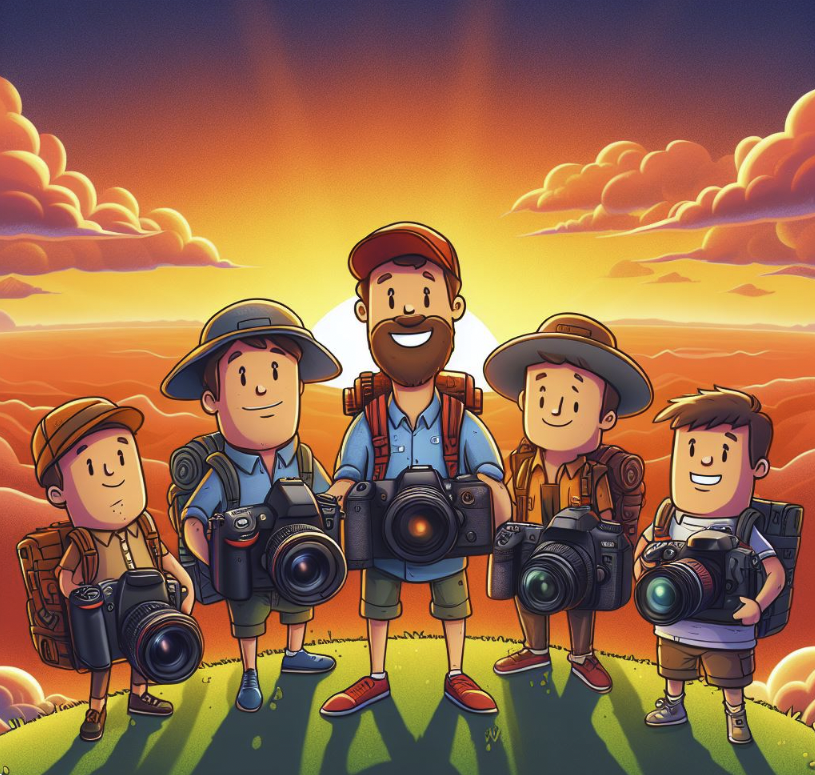When it comes to capturing moments and preserving memories, cameras have played a significant role in our lives.
Over the years, the photography industry has witnessed a remarkable transformation with the advent of digital cameras.
However, film cameras still hold a special place in the hearts of many photography enthusiasts.
One of the key debates in this realm revolves around the image quality offered by film cameras versus digital cameras.
Film Camera vs. Digital Camera
Film Camera:
- Medium: Uses film rolls to capture images.
- Image Creation: Images are chemically developed from film.
- Preview: No immediate preview of images.
- Cost per Shot: Each shot incurs a cost (film and development).
- Dynamic Range: Often praised for its aesthetic and dynamic range.
Digital Camera:
- Medium: Uses digital sensors and memory cards to capture images.
- Image Creation: Images are instantly available and can be edited digitally.
- Preview: Allows immediate preview and deletion of images.
- Cost per Shot: Virtually free, limited only by memory card capacity.
- Dynamic Range: Continuously improving but historically considered less aesthetic than film.
Film cameras offer a distinct, often appreciated aesthetic and a tactile, deliberate shooting experience.
Digital cameras provide immediate feedback, extensive creative control, and a cost-effective solution for high-volume shooting.
Below we look deeper at both types of cameras and explore the factors that contribute to their image quality.
Table of Contents
The Evolution of Cameras: From Film to Digital
Before we dive into the comparison, let’s take a brief look at the evolution of cameras.
Film cameras have been around for over a century and have been the primary tool for capturing photographs until the late 20th century.
These cameras use photographic film to record images, which are then developed and printed.
On the other hand, digital cameras emerged in the late 20th century and revolutionized the photography industry.
Instead of using film, digital cameras capture images using an electronic image sensor, which converts light into digital signals.
These signals are then processed and stored as digital files.
Understanding Image Quality
Image quality is a subjective term that encompasses various factors such as sharpness, color accuracy, dynamic range, noise levels, and overall visual appeal.
Let’s explore how film cameras and digital cameras perform in each of these aspects:
Sharpness
Film cameras have long been praised for their ability to produce sharp and detailed images.
The chemical process involved in developing film allows for high-resolution output, capturing intricate details with precision.
However, advancements in digital camera technology have narrowed the gap significantly.
Modern digital cameras with high megapixel counts and advanced lenses can produce images that rival the sharpness of film.
Color Accuracy
One of the distinctive characteristics of film photography is its unique color rendition.
Film emulsions are known for their ability to capture colors in a way that is often described as more natural and pleasing to the eye.
Digital cameras, on the other hand, rely on image sensors and image processing algorithms to reproduce colors.
While digital cameras have made significant strides in color accuracy, some photographers still prefer the unique color palette offered by film.
Dynamic Range
Dynamic range refers to the ability of a camera to capture details in both bright and dark areas of a scene.
Film cameras have traditionally excelled in this aspect, as they can handle high contrast scenes with ease.
Film’s ability to retain details in highlights and shadows is often attributed to its wider latitude compared to digital sensors.
However, modern digital cameras equipped with advanced sensors and HDR (High Dynamic Range) capabilities have closed the gap and can now produce images with impressive dynamic range.
Noise Levels
Noise, also known as grain in film photography, refers to the random variations in brightness and color that can degrade image quality.
Film cameras tend to exhibit a unique grain pattern, which some photographers find aesthetically pleasing.
However, film grain can also introduce a level of noise that may not be desirable in certain situations.
Digital cameras, on the other hand, have made significant advancements in reducing noise levels, especially in low-light conditions.
The latest digital cameras employ sophisticated noise reduction algorithms, resulting in cleaner images.
Overall Visual Appeal
Image quality is not solely determined by technical specifications but also by the overall visual appeal of the photographs.
This aspect is highly subjective and varies from person to person.
Some photographers argue that film cameras offer a certain charm and character that cannot be replicated by digital cameras.
The imperfections and unique qualities of film, such as light leaks and vignetting, contribute to the overall aesthetic appeal.
On the other hand, digital cameras provide instant feedback, allowing photographers to make adjustments on the spot and achieve the desired look.
Case Studies and Statistics
Let’s take a closer look at some case studies and statistics that shed light on the image quality offered by film cameras and digital cameras:
Case Study 1: National Geographic Photographers
National Geographic photographers are renowned for their exceptional photography skills.
Many of them have transitioned from film to digital cameras over the years.
According to a survey conducted by National Geographic, 80% of their photographers now use digital cameras for their assignments.
This shift can be attributed to the advancements in digital camera technology, which have allowed photographers to achieve high-quality images while enjoying the benefits of instant feedback and post-processing flexibility.
Case Study 2: Landscape Photography
Landscape photography often requires capturing intricate details, vibrant colors, and a wide dynamic range.
A study conducted by a renowned landscape photographer compared the image quality of film and digital cameras in various scenarios.
The results showed that while film cameras excelled in color accuracy and dynamic range, digital cameras produced sharper images with better noise control.
The study concluded that both types of cameras have their strengths and weaknesses, and the choice depends on the photographer’s preferences and shooting conditions.
Statistics: Market Share
Market trends also provide insights into the popularity of film cameras versus digital cameras.
According to a report by the Camera & Imaging Products Association (CIPA), digital camera shipments accounted for approximately 99% of the global camera market in 2024.
This statistic highlights the dominance of digital cameras in the industry.
However, it is worth noting that film photography has experienced a resurgence in recent years, with a growing community of photographers embracing the unique qualities offered by film.
FAQs – Film Camera vs. Digital Camera: Which Offers Better Image Quality?
1. Are film cameras still relevant in the digital age?
Yes, film cameras are still relevant in the digital age. Many photographers appreciate the unique qualities and aesthetic offered by film photography.
2. Do film cameras produce sharper images than digital cameras?
Film cameras have long been praised for their ability to produce sharp and detailed images.
However, advancements in digital camera technology have narrowed the gap significantly, and modern digital cameras can produce images that rival the sharpness of film.
3. Are digital cameras better at reproducing colors accurately?
Film cameras are often praised for their unique color rendition, which some photographers find more natural and pleasing to the eye.
However, digital cameras have made significant strides in color accuracy and can reproduce colors with great precision.
4. Do film cameras have a wider dynamic range than digital cameras?
Film cameras traditionally excel in handling high contrast scenes and retaining details in highlights and shadows.
However, modern digital cameras equipped with advanced sensors and HDR capabilities have closed the gap and can produce images with impressive dynamic range.
5. Do film cameras produce more noise than digital cameras?
Film grain, which is often considered a form of noise, can introduce a unique aesthetic to film photographs.
However, digital cameras have made significant advancements in reducing noise levels, especially in low-light conditions.
6. Can digital cameras replicate the charm of film photography?
Digital cameras provide instant feedback and post-processing flexibility, allowing photographers to achieve the desired look.
However, some photographers argue that film cameras offer a certain charm and character that cannot be replicated by digital cameras.
7. Why have most professional photographers switched to digital cameras?
Professional photographers have switched to digital cameras due to the advancements in technology, which have allowed them to achieve high-quality images while enjoying the benefits of instant feedback, post-processing flexibility, and faster workflow.
8. Are there any specific genres of photography where film cameras excel?
Film cameras are often favored in genres such as portrait photography, street photography, and fine art photography, where the unique qualities and aesthetic of film can enhance the overall visual appeal.
9. Can film cameras capture more details than digital cameras?
Film cameras have long been praised for their ability to capture intricate details with precision.
However, modern digital cameras with high megapixel counts and advanced lenses can produce images that rival the level of detail offered by film.
10. Are film cameras more expensive to use compared to digital cameras?
Film photography involves the cost of purchasing film rolls, developing, and printing.
On the other hand, digital photography eliminates these costs as images can be stored digitally.
However, digital cameras require investments in camera bodies, lenses, and memory cards.
11. Can film cameras produce images with a unique aesthetic?
Yes, film cameras can produce images with a unique aesthetic due to their imperfections and qualities such as light leaks, vignetting, and film grain.
12. Do digital cameras offer better versatility in terms of shooting modes and features?
Yes, digital cameras offer a wide range of shooting modes, features, and customization options that provide photographers with greater versatility and control over their images.
13. Can digital cameras capture images in low-light conditions better than film cameras?
Modern digital cameras have made significant advancements in low-light performance, thanks to improved sensor technology and noise reduction algorithms.
They can capture images in low-light conditions with less noise compared to film cameras.
14. Are film cameras more suitable for beginners or professionals?
Both film cameras and digital cameras can be suitable for beginners and professionals.
The choice depends on the photographer’s preferences, shooting style, and desired workflow.
15. Can film cameras offer a more tactile and immersive photography experience?
Many photographers appreciate the tactile and immersive experience offered by film cameras, as they require careful consideration of each shot and the anticipation of the final result during the development process.
Summary – Film Camera vs. Digital Camera: Which Offers Better Image Quality?
When it comes to image quality, both film cameras and digital cameras have their strengths and weaknesses.
Film cameras are known for their sharpness, unique color rendition, and wide dynamic range.
On the other hand, digital cameras offer instant feedback, better noise control, and the ability to produce sharp images with high megapixel counts.
The choice between the two ultimately depends on the photographer’s preferences, shooting conditions, and desired aesthetic.
As technology continues to advance, digital cameras are closing the gap and offering image quality that rivals film.
However, film photography still holds a special place in the hearts of many photography enthusiasts, who appreciate its timeless charm and character.
Related
- DSLR Cameras
- Mirrorless Cameras
- Action Cameras vs. Traditional Cameras
- Point-and-Shoot Cameras vs. DSLR Cameras


